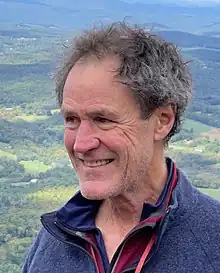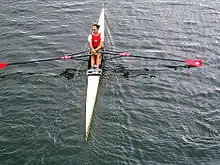 Biglow in 2022 | |||||||||||||||||||||
| Personal information | |||||||||||||||||||||
|---|---|---|---|---|---|---|---|---|---|---|---|---|---|---|---|---|---|---|---|---|---|
| Nationality | American | ||||||||||||||||||||
| Born | December 20, 1957 Seattle, Washington, United States | ||||||||||||||||||||
| Alma mater | Yale University, Dartmouth Medical School | ||||||||||||||||||||
| Occupation | Anesthesiologist | ||||||||||||||||||||
| Height | 190 cm (6 ft 3 in) | ||||||||||||||||||||
| Weight | 85 kg (187 lb) | ||||||||||||||||||||
| Sport | |||||||||||||||||||||
| Sport | Rowing | ||||||||||||||||||||
Medal record
| |||||||||||||||||||||
John Biglow (born December 20, 1957) is a retired American rower. Regarded as the best US single sculler of the early 1980s, he competed and finished fourth in the men's single sculls event at the 1984 Summer Olympics in Los Angeles.[1][2]
Biography
Biglow was born in Seattle after his father, Lucius Horatio, Jr., and mother, Nancy (née Wheatland), moved there from the east coast in 1954.[3] Biglow's grandfather, Lucius Horatio Biglow, was a noted Yale football player.[4]
He started sweep-oar rowing (rowing with a single oar in a boat with teammates), while attending the Lakeside School.[2][4][5]
Biglow continued rowing at Yale University. There he contributed to its successes in competing against Harvard University's rowing team, having proved that he was one the strongest oarsmen in the university's history on the ergometer, a stationary rowing machine.[5] He graduated from Yale in 1980 with a degree in psychology.[6][7]
He graduated as a Doctor of Medicine from Dartmouth Medical School in 1989 and did residencies at Rhode Island Hospital in general medicine and Massachusetts General Hospital in anesthesiology.[8]
After completing his medical training, Biglow became an anesthesiologist, practicing in Delaware and in Vermont.[2]
Athletic career
After his high school and college experience in sweep-oar rowing, Biglow switched to solo sculling (rowing with two oars) in 1981.[2] He was the best US single sculler in the early 1980s.[5] He was noted as powerful finisher, whose muscles allowed increasing output towards the end of a race, whereas other competitors might tire towards the end.[9] A biopsy of his muscles suggested that his ability lay in having 72% slow-twitch muscles, compared with readings in the mid-60-percent range of his peers.[10] His performance was compromised by chronic back pain.[9] Biglow began using a sliding-rigger single scull in 1982, which contributed to his personal best results.[11]
Yale crew
Biglow rowed in Yale's men's varsity heavyweight boat from 1978 through 1980. In 1978 and 1979 Yale won the Eastern Sprints. The 1979 boat, with Biglow at stroke, raced at the Henley Royal Regatta, triumphing over Oxford.[12][13]
Single sculls

He won bronze medals both at the 1981 and 1982 World Rowing Championships in Lucerne.[14]
In 1982,[15] Biglow held the course record in the Men's Championship Single for the Head of the Charles Regatta until it was bested by Norwegian, Kjetil Borch in 2013.[16][17]
He raced against former six strong competitors in the May 1984 Olympic trials, winning the final race and a place on the team by 0.9 seconds.[14] He had shown up for Olympic training in Cambridge, Massachusetts without a boat to vie for the position. With some difficulty, he secured a boat and the cooperation of the coach. He placed well in other qualifying races and raced at Olympic camp in California against his international competition, which had arrived for the games. Feeling that his leg strength was less than a few years before and that his back was an issue, Biglow decided to repeat his usual strategy of rowing his own race—not responding unnecessarily to the progress of his competitors. Vying for a bronze medal, he came in fourth against a strong field, missing the medal by 1.62 seconds after a strong finish surge.[5]
Double and quadruple sculls

Biglow also competed at the 1983 World Championships in quadruple sculls (gold medal) and at the 1985 championships in double sculls.[18]
He won a gold medal in double sculls with Greg Walker at the 1987 Pan American Games.[19][20]
International race results
The World Rowing Federation summarizes Biglow's international race results, as follows:[18]
| Event | Locale | Team | Race | Rank | Time |
|---|---|---|---|---|---|
| 1981 World Rowing Championships | Oberschleissheim/Munich, Germany | USA | Men's Single Sculls (FA) | 3 | 07:51.55 |
| 1982 World Rowing Championships | Rotsee/Lucerne, Switzerland | USA | Men's Single Sculls (FB) | 3 | 07:02.08 |
| 1983 World Rowing Championships | Wedau/Duisburg, Germany | USA | Men's Quadruple Sculls (F) | 1 | 05:57.93 |
| 1984 Olympic Games | Lake Casitas/Los Angeles, United States | USA | Men's Single Sculls (F) | 4 | 07:12.00 |
Portrayals
A 1984 Time survey of prospective Olympic athletes highlighted Biglow as a self-motivated, non-sponsored amateur athlete, devoted to his sport and the honor of competing against the world's best rowers.[7]
David Halberstam wrote about Biglow in a Vanity Fair article, "Striver's Row", and a book, The Amateurs.
The magazine article, with two portraits by Annie Liebowitz, provides background on Biglow's Yale rowing career and the events leading to his 1984 Olympic performance.[5] Much of the material is reprised in the book.
The book describes, in part, Biglow's development as an oarsman. Halberstam highlights the personal and team dynamics that led up to Biglow's rowing event in the 1984 Summer Olympics, which included overcoming back pain, finding a suitable race boat, convincing his rowing coach that he should race as a single, and his status compared with other rowers. The book portrays him as having an ethos that included a strong drive to excel, combined with personal modesty, and a strong sense that the dignity of his fellow competitors should be respected and upheld.[4] The book explored the nature of amateur sports, wherein athletes are motivated not by money, but the will to excel.[21][22]
He was portrayed in the movie, Rowing Through, a film adaptation of Halberstam's book.[23]
Peter Mallory captured substantial reminiscences in dialog form from Biglow and his contemporaries in The Sport of Rowing: Plus ça change.[11]
Further reading
- Halberstam, David (July 1985), Striver's Row, Vanity Fair, retrieved September 26, 2022
- Halberstam, David (December 18, 2012). The Amateurs: The Story of Four Young Men and Their Quest for an Olympic Gold Medal. Open Road Media. ISBN 978-1-4532-9513-7.
- Mallory, Peter (2011). The Sport of Rowing: Plus ça change (PDF). Vol. 4. River and Rowing Museum.
References
- ↑ Evans, Hilary; Gjerde, Arild; Heijmans, Jeroen; Mallon, Bill; et al. "John Biglow Olympic Results". Olympics at Sports-Reference.com. Sports Reference LLC. Archived from the original on April 18, 2020. Retrieved September 3, 2018.
- 1 2 3 4 "John Robinson Biglow". Olympics.com. Retrieved September 25, 2022.
- ↑ "Lucius Horatio Biglow Jr. Obituary (1925 - 2015)". Legacy.com. The Seattle Times. Retrieved September 28, 2022.
- 1 2 3 Halberstam, David (December 18, 2012). The Amateurs: The Story of Four Young Men and Their Quest for an Olympic Gold Medal. Open Road Media. ISBN 978-1-4532-9513-7.
- 1 2 3 4 5 Halberstam, David (July 1985). "Striver's Row". Vanity Fair | The Complete Archive. Vanity Fair. Retrieved September 26, 2022.
- ↑ Koivastik, Mart (July 17, 1980). "Olympic training worthwhile despite missing boat to Games". Journal-American. pp. C1-2.
- 1 2 Skow, John (July 30, 1984). "Olympics: Just Off Center Stage". Time. ISSN 0040-781X. Retrieved October 3, 2022.
- ↑ "MD20278 - Biglow, John Robinson, MD - OR License Verification - 09/26/2022 05:36:02 PM". omb.oregon.gov. Retrieved September 27, 2022.
- 1 2 Halberstam, David (July 22, 1984). "The Season of the Amateur". Parade Magazine. pp. 4–7.
- ↑ Lovitt, Michelle; Speraw, John (2004). Exercise for Your Muscle Type: The Smart Way to Get Fit. Basic Health Publications, Inc. ISBN 978-1-59120-066-6.
- 1 2 Mallory, Peter (2011). The Sport of Rowing: Plus ça change (PDF). Vol. 4. River and Rowing Museum.
- ↑ "Yale Crew Gains Final In Henley Royal Regatta". The New York Times. July 8, 1979. pp. S9. ISSN 0362-4331. Retrieved October 3, 2022.
- ↑ "History | Rowing". rowing.yale.edu. Retrieved October 3, 2022.
- 1 2 Hildes-Heim, Norman (May 7, 1984). "Bigelow[sic] Takes Rowing Trial". The New York Times. ISSN 0362-4331. Retrieved September 28, 2022.
- ↑ Raymond, Peter (October 1982). "The 1982 Head of the Charles". Rowing USA. pp. 11–13.
- ↑ Burdge, Margaret (October 21, 2013). "Photos: Head of the Charles Regatta 2013". Boston Magazine. Retrieved September 28, 2022.
- ↑ Connolly, John (October 20, 2013). "Rowing's Stone Age". Boston Herald. Retrieved September 28, 2022.
- 1 2 "World Rowing - John Biglow". World Rowing. Retrieved September 28, 2022.
- ↑ "John Biglow and Greg Walker of the USA compete in the Men's Double..." Getty Images. Retrieved September 28, 2022.
- ↑ "John Biglow wears his gold medal won with partner Greg Walker of the..." Getty Images. Retrieved September 28, 2022.
- ↑ Jerome, John (June 30, 1985). "The Shell Game". The Washington Post.
- ↑ Granberry, Mike (July 28, 1985). "The True Amateurs : In 'The Amateurs,' Author David Halberstam Discovers That the Olympic Spirit Still Burns Within Athletes Such U.S. Rowing Team Alternate Christopher Wood". Los Angeles Times. Retrieved September 28, 2022.
- ↑ Lewis, Brad Alan (October 20, 1996). Sitting through Rowing Through. The Independent Rowing News.